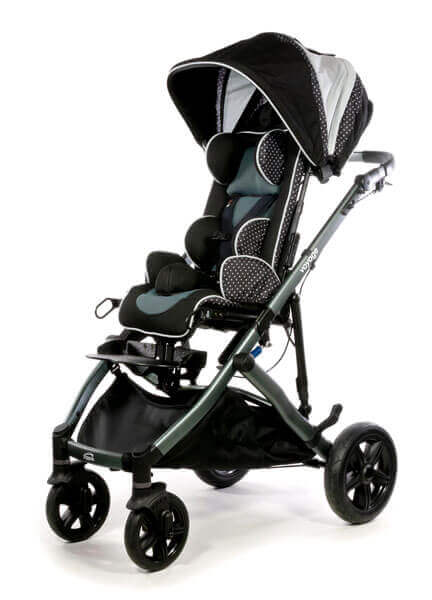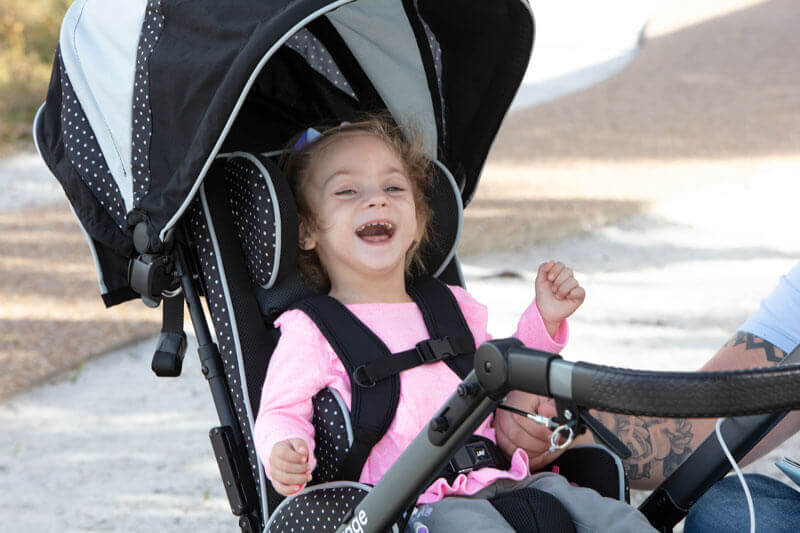When parents-to-be are preparing to welcome a child into their lives, there are various vital supplies they need to obtain – one of which is a travel system for the unborn child. Parents may spend hours researching various types of strollers to determine which one is ideal for their future child, lifestyle, and personal preferences. As the baby's due date draws closer, the parents have not only selected the ideal supplies for their bundle of joy, but they have likely pictures their child riding happily in that specific stroller. The stroller may have been given to them by family members at a recent baby shower, and since that celebratory event, the parents have continued to imagine themselves participating in outings with friends who have infants too, envisioning countless joyful scenarios they will experience as their new little one grows up. It is important that we, as clinicians and complex rehabilitation technology (CRT) providers, keep this in mind when recommending any therapeutic interventions to a family, including an early intervention adaptive stroller.
As members of the CRT provision team, you are encouraged to evaluate a child and recommend adaptive mobility equipment with a holistic approach, keeping in mind the abilities, desires, preferences, lifestyle, goals/future plans, personalities, etc., of the user and caregivers. In addition, taking into account the user's medical history, current physical status, medical needs, and funding source. By gathering all of this recommended information, the CRT provision team is able to conduct a feature match of the options of devices and components to help the family select the best solution for their child.
Before we dive into exploring the styles and various options currently available, let's take some time to review three frequently asked questions about the provision of early intervention adaptive strollers:
What is an early intervention adaptive stroller?

According to Merriam-Webster's Collegiate Dictionary, the word "stroller" is defined as "a collapsible carriage designed as a chair in which a smaller child may be pushed ("stroller", n.d.)." In terms of CRT, an early intervention adaptive stroller is considered to be a dependent stroller-type push wheelchair with seating components that can be selected and modified to meet the user's needs. The stroller bases may also include fixed tilt, tilt-in-space, and recline functions for changing positions (Lange & Minkel, 2018, pg. 286-287). An early intervention adaptive stroller is designed to be a dependent mobility device for infants to toddlers.
When is it appropriate to consider an early intervention adaptive stroller?
Areas to focus on to assist with answering this question include: age (size - height, seat depth and width, weight, etc.), medical considerations (history, diagnosis, current status, and prognosis), and gross motor skills (seating and mobility).
No matter the abilities or limitations of a child, creating opportunities for the child to experience and learn at the same rate as a child without disabilities is important. Utilizing a stroller to transport children in either a full-time or part-time capacity (for long distances) from infancy until 3-4 years of age is common for children without disabilities. Identifying the best age to start using an early intervention adaptive stroller is often dictated by the child's seating, positioning, medical, and developmental needs being able to be met via a mainstream stroller.
For example, if an infant diagnosed with Spinal Muscular Atrophy Type 1 on a ventilator with a gastrostomy tube needs a significant amount of postural support in order to not experience episodes of oxygen desaturation while riding in a stroller, then obtaining an early intervention adaptive stroller immediately is appropriate. As the same child grows and her cognitive skills develop, exploring opportunities for increased independent mobility (such as a power wheelchair) might be appropriate, particularly due to the fact that at the same time, her peers without disabilities would be learning to move independently. Also keep in mind physical growth of the child and the restrictions that funding sources may place on the length of time a seating system and mobility device should last the child.
What if parents or caregivers are hesitant to obtain an early intervention adaptive stroller for their child?
A few years ago, one of my non-industry friends, who is also the mother of adorable twin boys that were born at 32 weeks gestational age, said to me, "I understand the boys' therapists and doctors are trying to help them, but it seems like every time someone wants to talk to me, it's about one more thing that is wrong with one of them. I am about done." The reality is that parents of children with complex medical needs and disabilities are juggling a lot, so processing the information or recommendations made during a family meeting, or at the conclusion of a therapy session, might not be possible in the moment. As professionals who want the absolute best for your clients, it makes perfect sense that you believe an early intervention adaptive stroller is needed for one of your clients. However, it also makes sense that a parent may initially seem to be resistant to the idea.
There are a variety of reasons why parents might not initially want to entertain a discussion about their child being evaluated for an early intervention adaptive stroller. Some of these reasons may include:
- Being overwhelmed with their baby's complex medical needs
- Fear of looking different from other parents with their children
- Lack of understanding as to how proper postural support can benefit their baby's overall health and development
- Concerns about funding for the device
- Belief that a stroller considered to be a piece of medical equipment will not meet their functional needs or personal preferences, etc.
Providing parents with the answers to their questions and helping to educate them about the equipment in an approachable way is often the best way to decrease hesitations.

As mentioned earlier, taking a holistic approach when evaluating a client and making equipment recommendations is essential. This theory applies to getting a complete picture of the parents' needs, desires, goals, and concerns in the beginning. It is possible that building the rapport to learn what parents truly feel and all that they are experiencing may include more than one conversation. But taking the time to understand the parents and family as a whole is vital to gain buy-in and increase the likelihood of the recommended equipment being properly utilized. Be proactive with the family by being prepared to review and provide resources to them on the equipment you are considering. By showing a parent images or videos of potential equipment, you are helping them to create a more accurate vision of what you are thinking, as opposed to one they may be picturing when you say "adaptive stroller."
Be sure to check out part two of this blog to learn about the various styles and options available on early intervention adaptive strollers.
Thank you for reading our blog! We love hearing from you, so please do not hesitate to reach out to us. We encourage you to leave a comment below.
Always remember at the end of the day, your client is your number one priority!
- Angie
Follow Angie on Twitter @ATigerKiger
References
- Stroller. (n.d.). In Merriam-Webster.com dictionary. Retrieved from https://www.merriam-webster.com/dictionary/stroller.
- Lange, M. L., & Minkel, J. (2018). Seating and wheeled mobility: A clinical resource guide. Thorofare, NJ: Slack Incorporated.